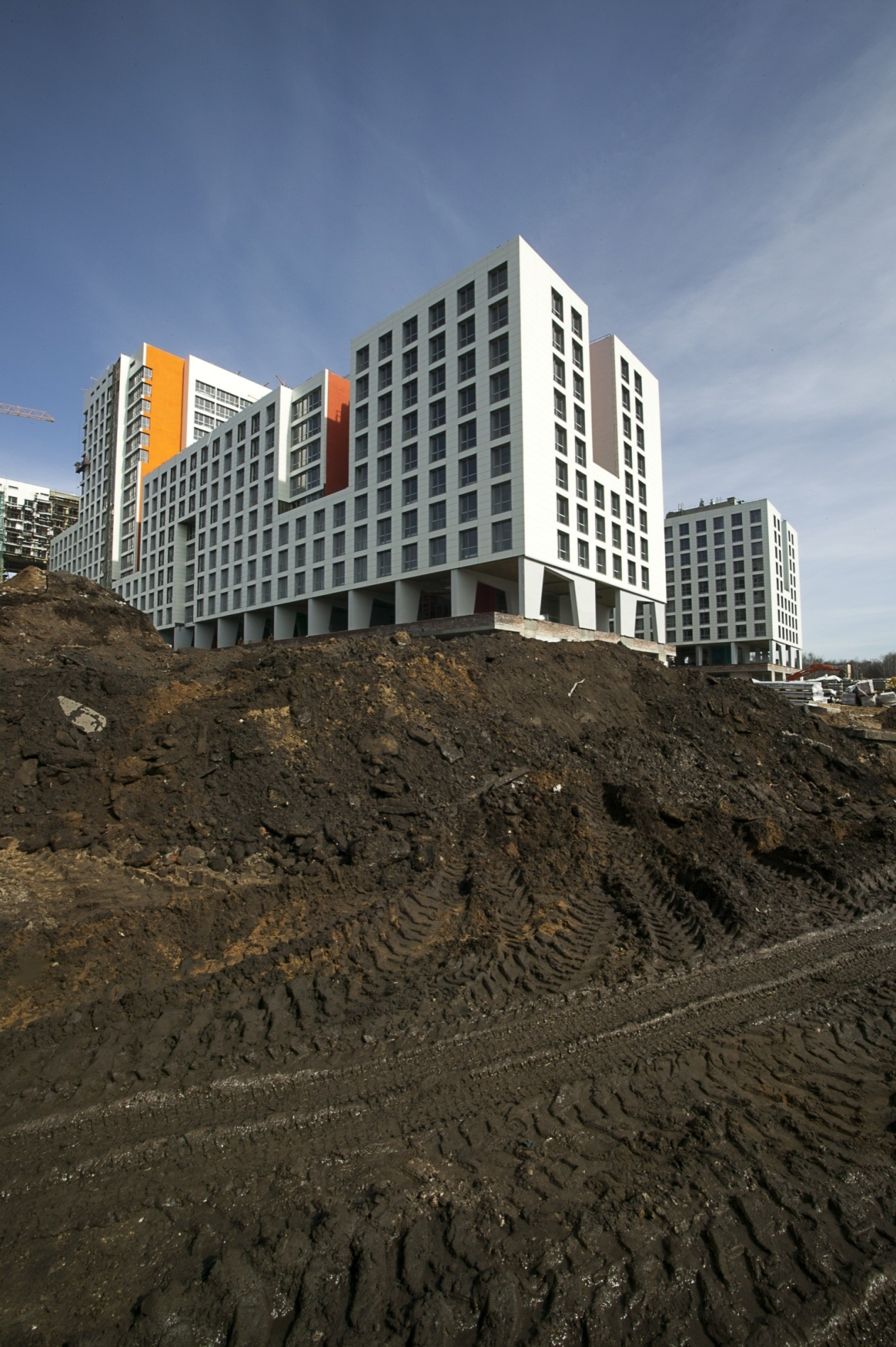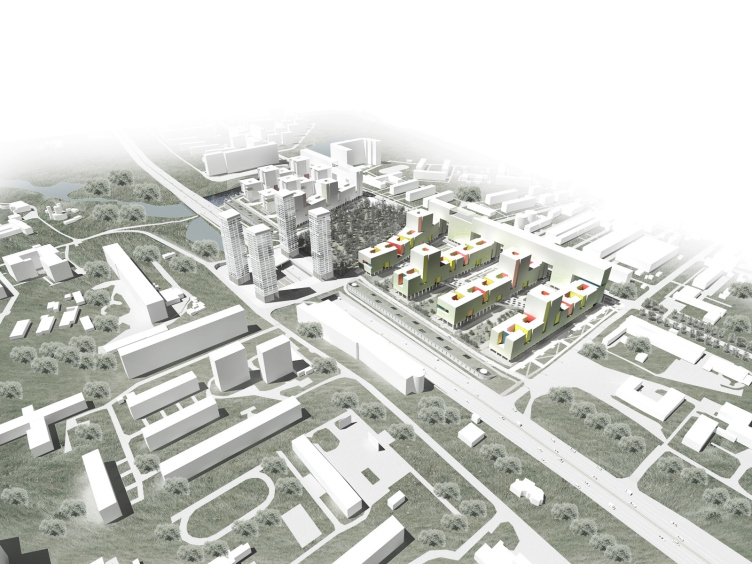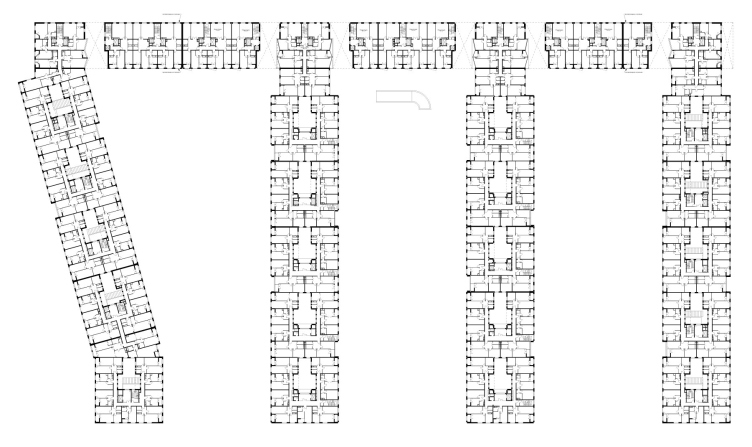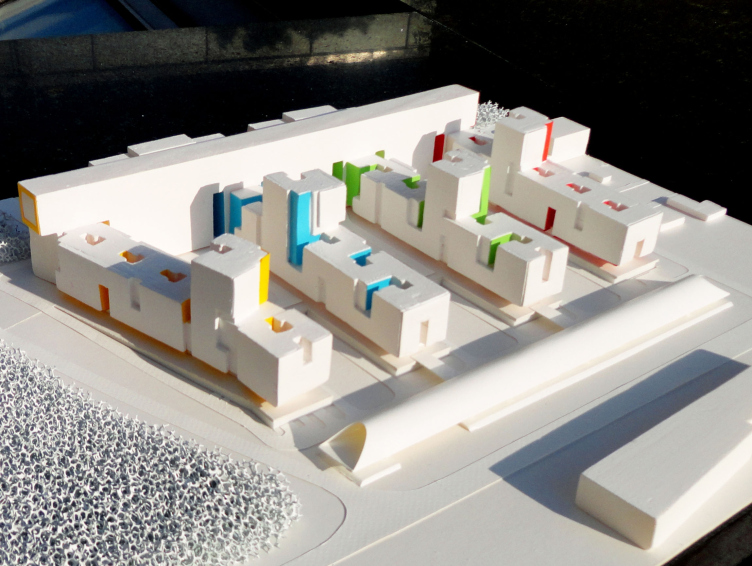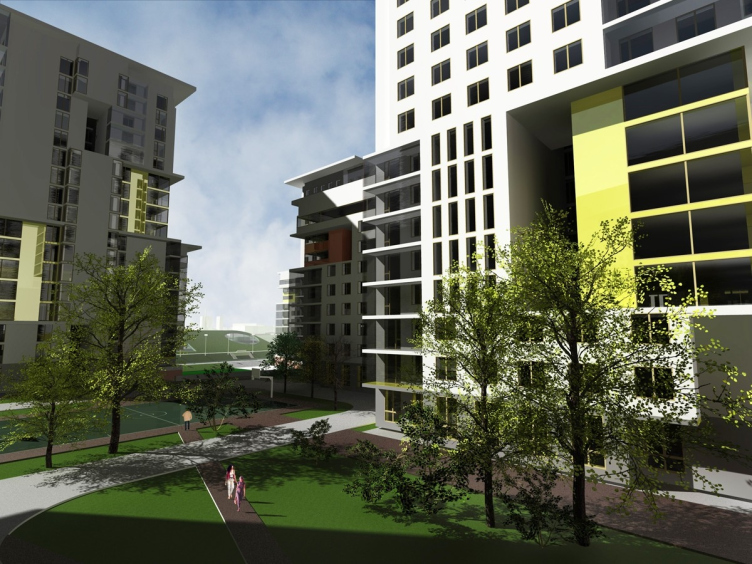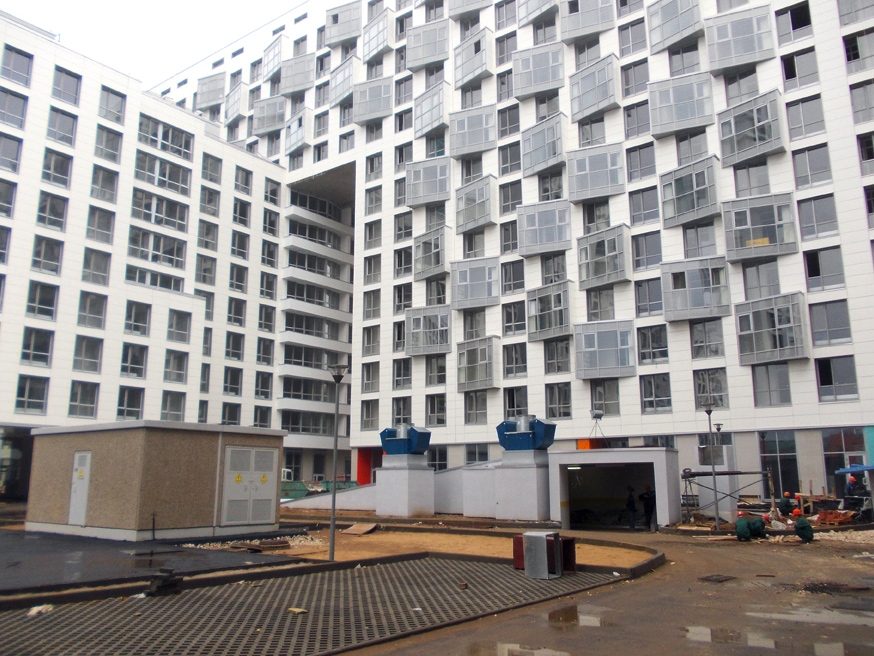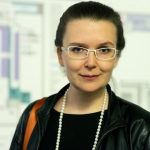
Two parts of the complex, separated by the ex-xemetery, and the towers of the business center over the Gorky Highway. Project. Image courtesy of "Ostozhenka" Bureau.
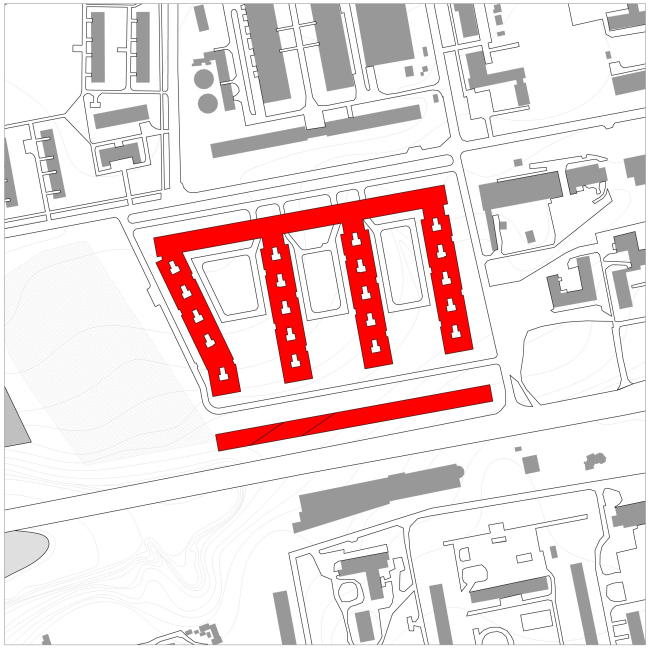
In 2008, 'Ostozhenka' Bureau was approached by the young and dynamic
company 'Tekta' that proposed to design a large-scale residential complex in
the center of Balashikha. At that particular moment, the commissioner's
portfolio only included one complete project in the city of
Speaking of the experiments - the very construction site lent itself to
them. The site is situated in the heart of Balashikha, between two highways -
Gorky Highway M7 traversing the city from east to west and its duplicate - the
city's "Main Street" named "Lenin Avenue". All the surroundings
literally revel in verdure, the western border of the site being marked by the
still-intact cascade of man-made lakes stretching along the
In the early 2000's, the city council even organized an international
tender for the building of the "Center" - this is how this area is
referred to in Balashikha. Teams from
Being very much in the know of Balashikha's town-planning issues, the
'Ostozhenka' architects took the commissioner's proposal as a chance to make a
positive difference in the life of the entire city. This is why, concurrently
with designing the new residential complex, they developed a project of two
high-capacity flyovers on the

Plan of the ground floor. Photo courtesy by "Ostozhenka" Bureau.
As for the "Center", being practically devoid of all of its
functions, it became the construction site for a housing project. And what a
project it is! Diluted with splashes of colors, the complex got a poetic name
of "Akvareli" ("Watercolors"). It looks like a watercolor
painting indeed that, while keeping the fragments of the white sheet, fills its
space with colors with a multitude of reflections, which is enhanced by the
abundance of water around the complex... The river, the lakes... But first
things first!
Presently, in construction is the block named 'East', while the block
named 'West' (so the authors call the constituent parts of the complex) is
still in the concept phase (we will give it a more detailed coverage in our
next issues). The two equal-sized blocks are separated by a green stripe of the
park. As the chief architect of the project Rais Baishev shared, this is not just
any park. Once there was the graveyard of the ancient settlement, then there
was a cemetery. From the middle of the last century it has been closed; now it
is overgrown with tall trees and has a status of a memorial park. It is still
hard to say if the dwellers of the future complex will be OK with this
vicinity. "In
The idea to fill the site up with a forest of high-rise towers was
dismissed at once - the architects tried to make the buildings as low rise as
it was possible in this situation. Keeping up the necessary number of square
meters was only possible due to the use a mixed typology: they crossed the
tower, sectional, and gallery types of housing. This is not its only
peculiarity, however: the residential complex became a veritable collection of
the architects' favorite techniques, if not to say - archetypes of classic
modernism.
Its plan looks very much like a hair comb with four long raked teeth.
The teeth reach out in the direction of the highway, while their
"base", the handle of the imaginary comb, is stretched along the
boulevard and is in fact a 14-story house some 300 meters long. It might be a
"wall house" or even a "beam house". If one looks from the
highway side or, better, yet, from the bird's height view, it becomes evident
that the four transverse buildings are supporting a long beam, and the whole
thing becomes a "horizontal skyscraper". However, the space above the
beam is filled with residential quarters (it would have been a shame to lose so
much of the square footage), and, when viewed from the boulevard side, it looks
indeed like a "wall house", the closest kin of the famous building at
Tulskaya metro station. The house is pierced with three driving openings,
though, that let the sun rays into the shady side, and provide access to the
three large courtyards of the complex. Because of the 9-story height, these
openings look more like narrow slits, while the whole house, when viewed from a
distance, looks like a centipede elephant making its way along the boulevard -
drawn, though in a simplified manner, but still with a good likeness. Thus, the
gigantism of the complex is the more evident from the side of the city blocks.

Maquette. Photo courtesy by "Ostozhenka" Bureau.
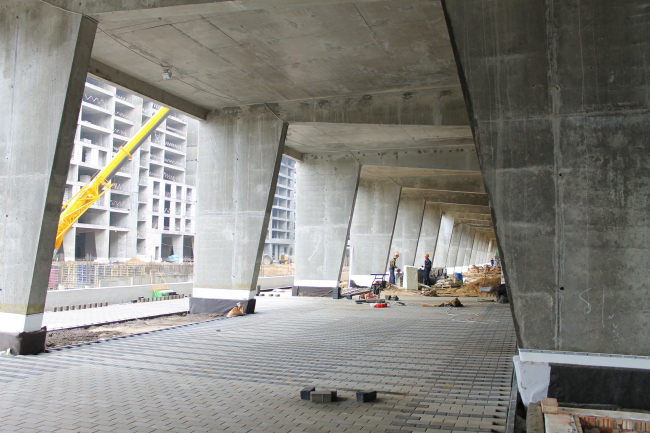
The four 9-story buildings (the teeth of the "comb"), turned
in the direction of the highway, and, in the farther perspective, to the
Golitsino Manor, were made as low-rise as possible. The logic way to reduce the
height without losing the square meters would be increasing the breadth, which
resulted in each building being 30 meters thick which is twice as much as the
average residential building. Because of that, the architects turned these
buildings into sequences of rectangular (almost square) sections, each one with
a courtyard of its very own. Inside, the courtyards are overlooked by the
corridors that connect the apartments and it turns out that each block is in
fact a gallery house that, like a snail, coils around its "light"
center. One of the blocks of each building grows from nine to seventeen floors,
and thus the four towers appear.
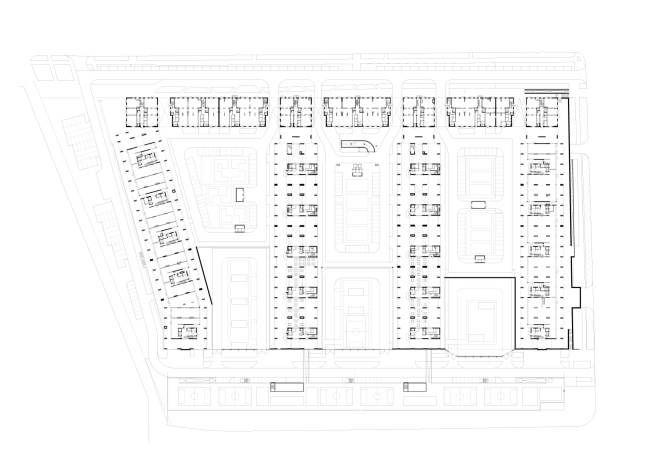
Plan of the zero floor. Image courtesy by "Ostozhenka" Bureau.
Further on, the modernist classic in its pure form begins. All the four
buildings, just as was bequeathed by Le Corbusier, are put upon supporting
pillars. The ground floors are non-residential and the transmissibility of the
pedestrian area is violated in but a few spots by a few shops and cafes, set up
in between the concrete "legs" of the two outer buildings and marking
the border of the territory in a punctured line; also - by the inevitable
blocks of stairwells, elevators, and lobbies with transparent glass walls. In
different versions of the project, the legs look different: sometimes they are
thin and have a square section, sometimes they are flat and trapeze-shaped,
like the "Unité d'Habitation" or
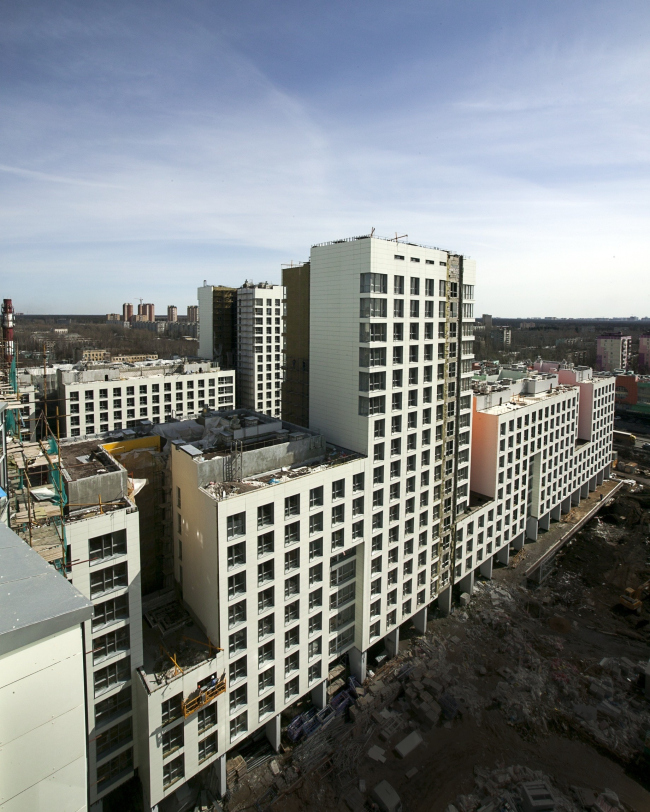
"Watercolor" residential complex. Photo by Aleksey Lerer, April 14, 2013, in the process of construction. Courtesy by "Ostozhenka" Bureau.
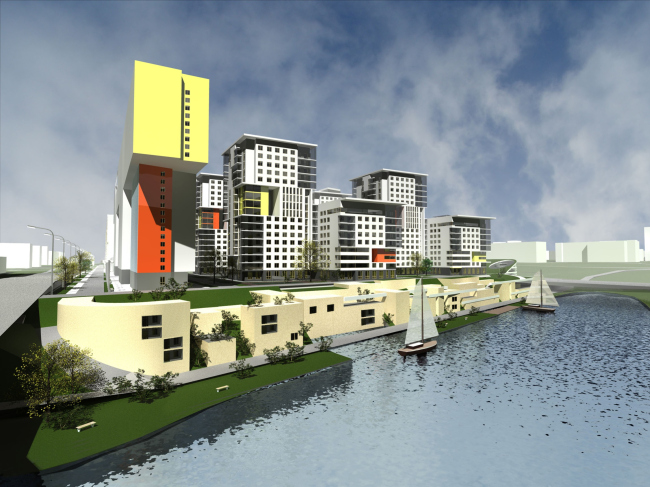
View fromn the water area. Project. Photo courtesy by "Ostozhenka" Bureau.
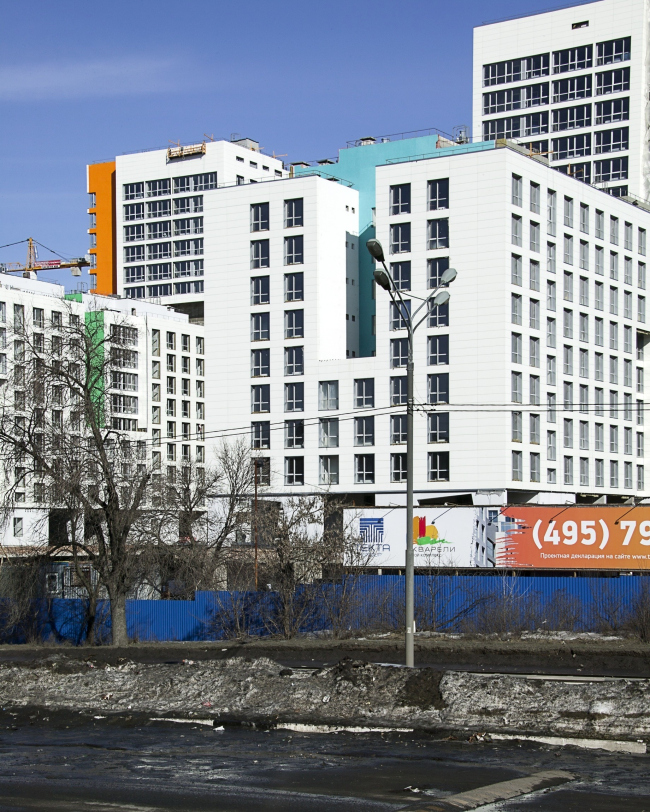
"Watercolor" residential complex. Photo by Aleksey Lerer, April 14, 2013, in the process of construction. Courtesy by "Ostozhenka" Bureau.
As if answering the transmissibility of the lower tier, the upper parts of the buildings also get a lot of slits. First of all, this refers to the sections with the inner courtyards - the slits allow for letting more light inside. For the 17-floor towers, whose yards are true "wells", the deep slits are all but mandatory: over the fifth floor their pan is no longer square but П-shaped.
The slits are echoed by large niches: here and there the architects cut
out of the wall a fragment some five floors high and about a meter deep.
When they do this, it turns out that, in spite of the fact that the skin
of the buildings is dazzling white (from fiber-cement panels), they are colored
on the inside. This is like cutting open a watermelon and finding the red pulp
inside the green peel. Everything that is on the outside is achromatic-white
but once we get inside - no matter in which manner, by going through the lobby
or simply observing the cutaway on the facade that the architects made in the
prismatic volume - it turns out that the house is color, very much so. Each
building has a color of its own: red, blue, green, and yellow - we see it in
the recessions, in the yards, in the hallways, on the surfaces of the walls and
on the ceilings of the permeable first tier. In a few versions of the project,
this same color appears on the lower surface of the protruding marquees.

Yard territory. Project. Image courtsey by "Ostozhenka" Bureau.
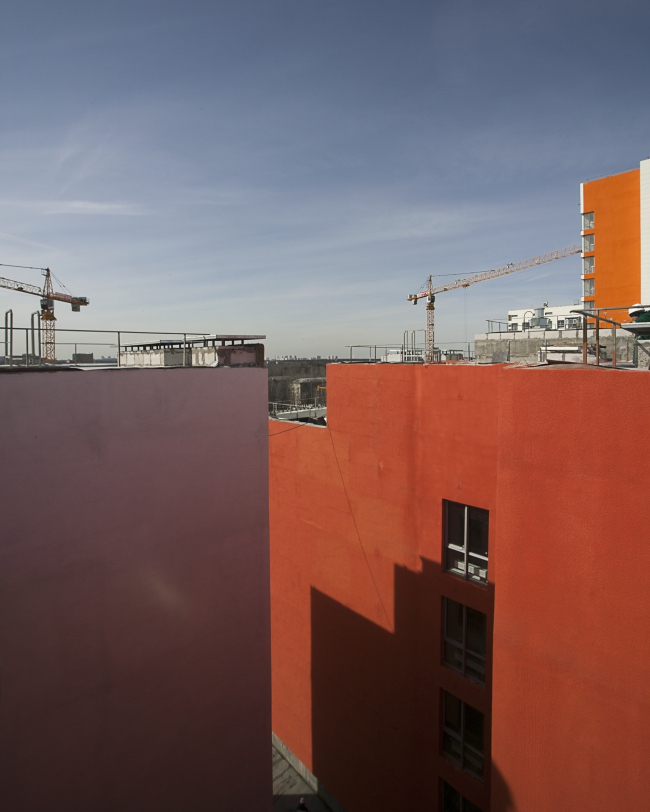
"Watercolor" residential complex. Photo by Aleksey Lerer, April 14, 2013, in the process of construction. Courtesy by "Ostozhenka" Bureau.

"Watercolor" residential complex. Photo by Aleksey Lerer, April 14, 2013, in the process of construction. Courtesy by "Ostozhenka" Bureau.
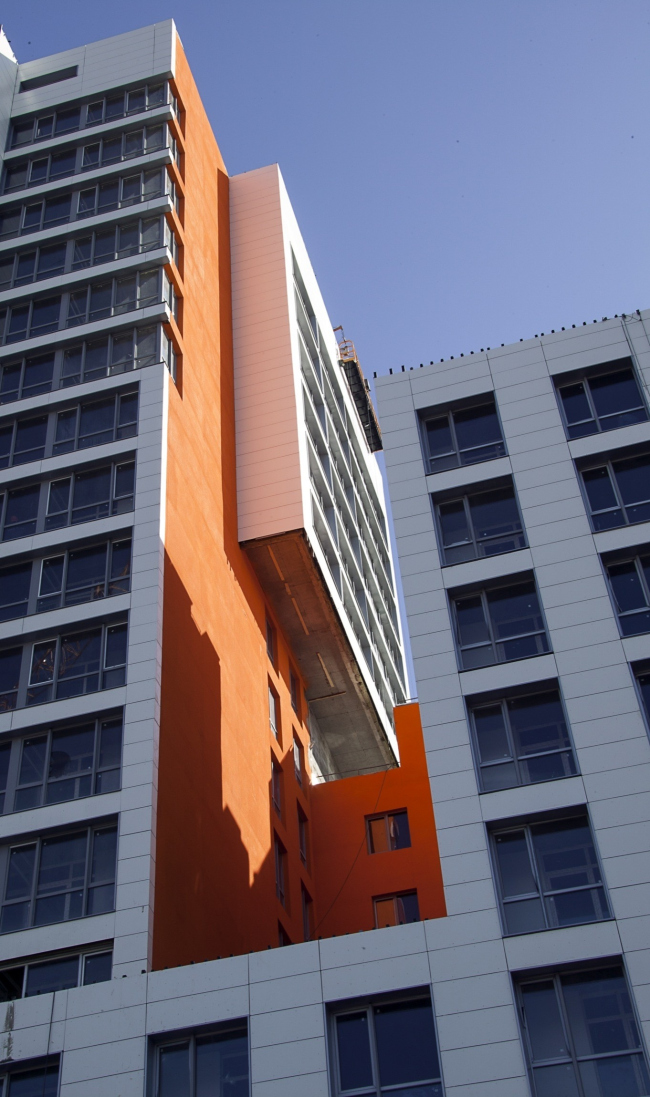
"Watercolor" residential complex. Photo by Aleksey Lerer, April 14, 2013, in the process of construction. Courtesy by "Ostozhenka" Bureau.
The color that is used is bright and simple; the shades appear thanks to
the reflections of the colors on the dazzling white surfaces of the wall (they
will look particularly bright in the sunny days). It is at this point that the
"watercolor" takes full effect: the color is dissolved in the
whiteness of the walls in very much the same way that the water-diluted color
falls on the white sheet of paper that "shines through". This effect
also looks a lot like a "wash drawing" - when the brush touches the wet
paper, the color immediately spreads out and makes colorful stains very much of
the kind that will appear on the walls of this building during the sunny days.
This technique, as is easy to guess, was again invented by the
already-mentioned Le Corbusier, who, inspired by Mondrian, painted the slants
of the recessed balconies of the "Unités d'Habitation" into the
bright basic colors and eventually got a more sophisticated perception of the
basic colors when viewed not directly but in perspective.
This motif, that is simultaneously simple and
sophisticated, has become one of the favorites in the contemporary
infrastructure: the colored partitions and color reflexes are very popular,
suffice it to recall the Japanese experiments of the French EMMANUELLE MOREAU.
The "Ostozhenka" version is more large-scale, and it is not devoid of
some extra meaning: color will become the characteristic mark of each hallway -
while passing through the yards one will not have a chance of making a mistake,
so strong will be the immersion into the color that is going to shine from up
above and get reflected in the pavement.
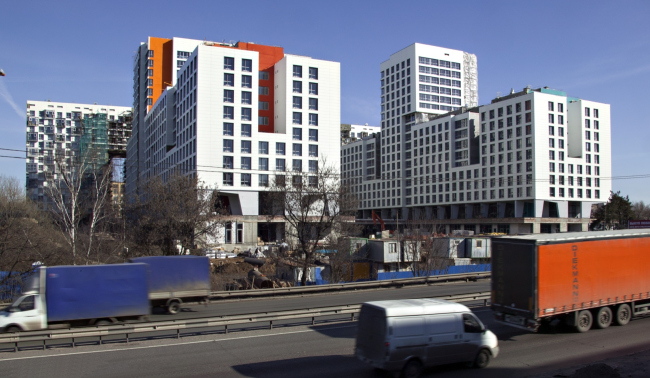
"Watercolor" residential complex. Photo by Aleksey Lerer, April 14, 2013, in the process of construction. Courtesy by "Ostozhenka" Bureau.
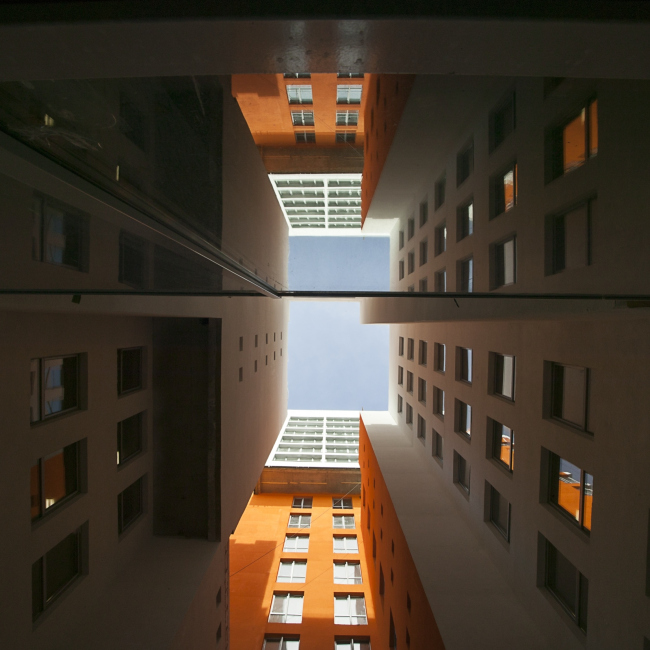
"Watercolor" residential complex. Photo by Aleksey Lerer, April 14, 2013, in the process of construction. Courtesy by "Ostozhenka" Bureau.
As we can see, the giant housing complex in Balashikha
uses the best traditions of modernism. What is interesting, however, is the
fact that these traditions in this particular case are not formally present
("look, we're paying homage to avant-garde here") but are fully used
to organize the urban space and give new meaning to it, proving spectacular and
relevant. In this sense, "Watercolor" district is the living and
righteous heir of the pilot districts of the 1970's, from which in this country
only one, namely Chertanovo, was built; in the European countries such blocks
are pretty wide-spread (see, for example, the Archi.ru feature on
However, it is easy to see that "Watercolor"
is not identical to the neighborhoods of classical modernism. They would have
hardly been so respectful of the context or would have tried to reduce the
number of floors because of the neighboring manor house; the sequences of the
courtyards would hardly have been possible either - this motif refers us to the
tenement houses of Saint Petersburg or, to be more exact, Italian palazzos with
galleries built around the courtyards; modernists, on their part, preferred
"slab" houses. Towers were not much favored in the 1970's, either. This
is why in the Balashikha house we see rather an alloy of the classic modernist
techniques and later, more subtle, solutions justified by the context,
insolation, and other conditions. But then again, nobody thought that
'Ostozhenka' would settle for less.

Yard vies between Buildings 2 and 3. Photo by A.Gnezdilov, October 2012. Courtesy by "Ostozhenka" Bureau.

Courtyard view in the summer of 2013; the facade of the "long" building with diagonal recessed balconies is almost complete. Photo from the "construction diary" from the residential complex website www.wcolour.ru


